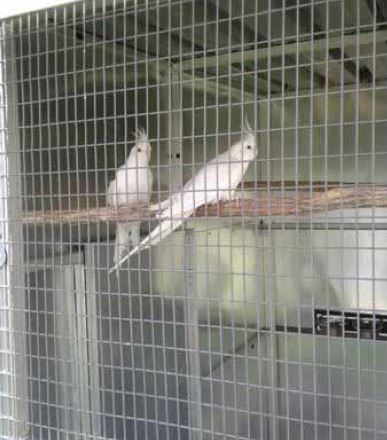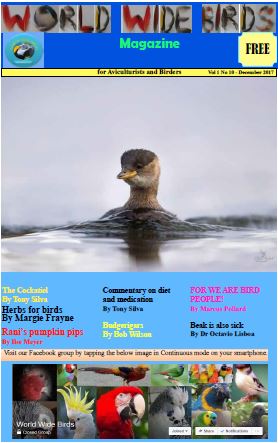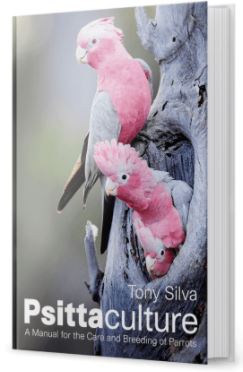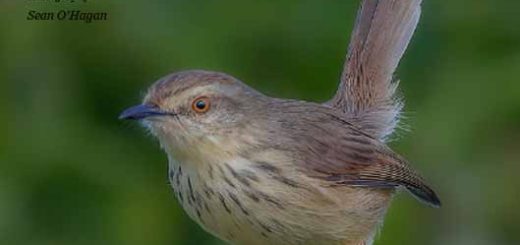Caring feeding and breeding cockatiels
Caring, feeding, and breeding cockatiels
By Tony Silva
The worldwide obsession is for a large parrot. Everyone, including a beginner with no experience, wants a large parrot. They are certainly gaudy, intelligent, and can make a good pet if you have some experience in handling larger parrots. That these individuals overlook the Cockatiel Nymphicus hollandicus is, unfortunately, for it is almost the perfect pet, being quiet, gentle, beautiful, capable of whistling and some of talking, and is readily available at a price that suits every pocketbook. Its ubiquity has resulted in them often being neglected. Breeders often feed them poorly or offer them conditions that doom the chicks they produce. In this article, I would like to address some basic care information that will result in the full potential of the Cockatiel as a pet or aviary bird being reached.
They taught me many lessons
The Cockatiel was one of the first parrots I bred. They taught me many lessons about the importance of nest hygiene, diet, and hand-rearing. That foundation persists with me today, more than 40 years after I acquired my first pair. I have always liked the species and recently began to keep them again. This renewed interest came about when I walked into a feed store and saw a group that was doomed to die. They were suffering from bacterial and fungal infections. I bought them and placed them in our quarantine room. Cultures were performed, revealing a severe bacterial infection. They were also suffering from yeast—a problem that is incipient in this species.
Caring, feeding, and breeding cockatiels
Because the Cockatiel is inexpensive and breeds readily many breeders believe they require no effort. They feed millet seeds, occasionally some oats, and if the birds are lucky wheat or husked rice. When they breed, the chicks quickly begin to show signs of malnutrition: stunted sizes, poor weight gains, and illness—their eyes become shrunken, they show dehydration, they lose condition and they die. I have in recent decades seen Cockatiels that because of this neglect were no bigger than an English Budgerigars Melopsittacus undulatus. The situation is aggravated when the breeders use pots. These ceramic receptacles are nothing more than a death trap unless they are cleaned continuously. Most breeders do not understand this. When I ask to see chicks from such nests their nails are often covered in globules of dried fecal matter. I have even seen pots in which maggots proliferated.
Nest box
Breeders that use pots need to understand the harm that they are causing their birds unless they are cleaned daily. I invariably get very angry when I see pots in use because I know that only a handful will keep them clean. A wooden nesting box is a much healthier alternative. The pair can chew slivers of wood from the walls to help maintain hygiene.
The wood is more porous and will absorb some of the liquid in the droppings. It is also easier to clean, which I recommend occurs at least once weekly while chicks are being reared. In slightly deep wooden nests one can add shavings to make the nest more sanitary. These shavings can be changed weekly. The other common mistake with Cockatiels is diet. In birds, you get back what you put into them. You cannot expect robust, healthy young from a poor diet. There is no other reality.

Caring, feeding, and breeding cockatiels
Cockatiels can be kept on either a pelleted or seed mix. I prefer non-colored pellets, as I believe the dyes used to color the pellets irritate the gut and make the birds vulnerable to yeast infection. If pellets are not available, then a seed mix is recommended. I would mix 2-3 types of millets, oats, wheat, milo, barley, buckwheat, and a little hemp, small sunflower, or safflower, the latter three especially if they are nesting. This seed diet alone is not nutritious and must be supplemented with other items.
Whole grain bread, greens (kale, Moringa leaves, collard greens, endive, carrot and beet tops, spinach, the pads of Opuntia cactus, and more), vegetables (steamed carrot, pumpkin and broccoli, and raw peas), and some egg food. In tropical areas, Moringa (called Drumstick tree in India) is incredible food, with the birds eating the pods, leaves, and bark. Moringa contains 9 essential amino acids, is rich in plant-based iron and fiber, as well as vitamins A and K, protein, calcium, magnesium, and antioxidants.
The plant can be fed fresh or the leaves can be dried, crushed and the powder added to the egg food. In addition, the plant is super fast-growing and does not require much attention. I do not favor feeding fresh corn or fruits, as the sugar content in these can augment a yeast infection; only field corn that is not sweet can be used, and then it should be offered fresh.
Egg food
The egg food is made from a boiled egg, grated carrot, endive, wheat germ, and whole-grain bread, all put through a food processor and made into a crumbly mixture. This mix can be stored in the refrigerator for use for no more than three days. I do not normally recommend feeding egg food to parrots but for Cockatiels, lovebirds, and Budgerigars it is a means of providing nutritious food. The egg food should not be fed throughout the year but only to induce breeding and to provide rich, digestible food for rearing young. One Indian breeder who used this food produced young that an average was 18% heavier simply by augmenting a totally deficient seed diet with egg food.
When feeding egg food it is important to ensure that it does not spoil or that the fallen bits do not sit in a cage, where the birds can eat them later. Hygiene is always important but even slight negligence when feeding egg food can result in dead birds.
Pet birds can be fed the above diet minus the egg food.
Vitamin/mineral supplement
A vitamin/mineral supplement can be added to steamed vegetables or egg food. I do not subscribe to the use of water-soluble vitamins. Normally the birds have to drink such a large volume to obtain any benefit that it makes little or no difference. Moreover, in a warm climate, the vitamins and minerals deteriorate quickly once in the water.
Finally, if this supplement has some sweetener added to make it more palatable, the risk of yeast infection is increased. When birds are fed a balanced diet there is no need for a vitamin/mineral supplement.
This article, How to care, feed and breed cockatiels, as well as a discussion about hand-rearing cockatiels, is in the below-mentioned edition that can be downloaded:

Tony’s book Psittaculture, is available from:




Perfect
I enjoy it😍😍🦋🌻
Thank you, glad you like and can learn something new 🙂